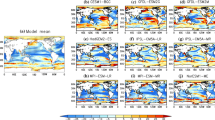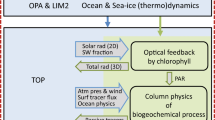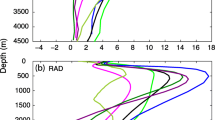Abstract
A key question in studies of the potential for reducing uncertainty in climate change projections is how additional observations may be used to constrain models. We examine the case of ocean carbon cycle models. The reliability of ocean models in projecting oceanic CO2 uptake is fundamentally dependent on their skills in simulating ocean circulation and air–sea gas exchange. In this study we demonstrate how a model simulation of multiple tracers and utilization of a variety of observational data help us to obtain additional information about the parameterization of ocean circulation and air–sea gas exchange, relative to approaches that use only a single tracer. The benefit of using multiple tracers is based on the fact that individual tracer holds unique information with regard to ocean mixing, circulation, and air–sea gas exchange. In a previous modeling study, we have shown that the simulation of radiocarbon enables us to identify the importance of parameterizing sub-grid scale ocean mixing processes in terms of diffusive mixing along constant density surface (isopycnal mixing) and the inclusion of the effect of mesoscale eddies. In this study we show that the simulation of phosphate, a major macronutrient in the ocean, helps us to detect a weak isopycnal mixing in the upper ocean that does not show up in the radiocarbon simulation. We also show that the simulation of chlorofluorocarbons (CFCs) reveals excessive upwelling in the Southern Ocean, which is also not apparent in radiocarbon simulations. Furthermore, the updated ocean inventory data of man-made radiocarbon produced by nuclear tests (bomb 14C) enable us to recalibrate the rate of air–sea gas exchange. The progressive modifications made in the model based on the simulation of additional tracers and utilization of updated observational data overall improve the model’s ability to simulate ocean circulation and air–sea gas exchange, particularly in the Southern Ocean, and has great consequence for projected CO2 uptake. Simulated global ocean uptake of anthropogenic CO2 from pre-industrial time to the present day by both previous and updated models are within the range of observational-based estimates, but with substantial regional difference, especially in the Southern Ocean. By year 2100, the updated model estimated CO2 uptake are 531 and 133 PgC (1PgC = 1015 gram carbon) for the global and Southern Ocean respectively, whereas the previous version model estimated values are 540 and 190 PgC.
Similar content being viewed by others
References
Anderson LA, Sarmiento JL (1995) Global ocean phosphate and oxygen simulations. Glob Biogeochem Cycles 9(4):621–636
Aumont O, Orr J, Monfray P, Madec G, Maier-Reimer E (1999) Nutrient trapping in the equatorial Pacific: the ocean circulation solution. Glob Biogeochem Cycles 13:351–369
Broecker WS, Peng T-H, Ostlund G, Stuiber M (1985) The distribution of bomb radiocarbon in the ocean. J Geophys Res 90:6953–6970
Broecker WS, Sutherland S, Smethie W, Peng T-H, Ostlund G (1995) Oceanic radiocarbon: separation of the natural and bomb components. Glob Biogeochem Cycles 9:263–288
Cao L, Jain A (2005) An Earth system model of intermediate complexity: simulation of the role of ocean mixing parameterizations and climate change in estimated uptake for natural and bomb radiocarbon and anthropogenic CO2. J Geophys Res 110:C09002 DOI 10.1029/2005JC002919
Conkright ME, Garcia HE, O’Brien TD, Locarnini RA, Boyer TP, Stephens C, Antonov JI (2002) World Ocean Atlas 2001, vol. 4, Nutrients, NOAA Atlas NESDIS 52. Natl Oceanic and Atmos Admin, Silver Spring, MD
Doney SC et al (2004) Evaluating global ocean carbon models: the importance of realistic physics. Glob Biogeochem Cycles 18:GB3017 DOI 10.1029/2003GB002150
Duffy PB, Caldeira K, Selvaggi J, Hoffert MI (1997) Effects of subgrid-scale mixing parameterizations on simulated distributions of natural 14C, temperature, and salinity in a three-dimensional ocean general circulation model. J Phys Oceanogr 27:498–253
Dutay J-C et al (2002) Evaluation of ocean model ventilation with CFC-11: comparison of 13 global ocean models. Ocean Model 4:89–120
Edwards NR, Marsh R (2005) Uncertainties due to transport-parameter sensitivity in an efficient 3-D ocean-climate model. Clim Dyn 24:415–433
England MH, Rahmstorf S (1999) Sensitivity of ventilation rates and radiocarbon uptake to subgrid-scale mixing in ocean models. J Phys Oceanogr 29:2802–2827
England MH, Maier-Reimer E (2001) Using chemical tracers to assess ocean models. Rev Geophys 39:29–70
Enting IG, Wigley TML, Heimann M (1994) Future emissions and concentrations of carbon dioxide: Key ocean/atmosphere/land analyses, Tech. Rep. 31, Div. of Atmos. Res., Commonw. Sci. and Ind. Res. Organ., Melbourne
Fiadeiro ME (1982) Three-dimensional modeling of tracers in the deep Pacific Ocean, 2, Radiocarbon and the circulation. J Mar Res 40:537–550
Gehrie E, Archer D, Emerson S, Stump C, Henning C (2006) Subsurface ocean argon disequilibrium reveals the equatorial Pacific shadow zone. Geophys Res Lett 33:L18608 DOI 10.1029/2006GL026935
Gent PR, Willebrand J, McDougall TJ, McWilliams JC (1995) Parameterizing eddy-induced tracer transports in ocean circulation models. J Phys Oceanogr 25:463–474
Gnanadesikan A (1999) A simple predictive model for the structure of the oceanic pycnocline. Science 283:2077–2079
Gnanadesikan A, Slater RD, Gruber N, Sarmiento JL (2002) Oceanic vertical exchange and new production: a comparison between models and observations. Deep Sea Res, Part II 49:363–401
Guilderson T, Caldeira K, Duffy PB (2000) Radiocarbon as a diagnostic tracer in ocean and carbon cycle modeling. Glob Biogeochem Cycles 14:887–902
Harvey LDD (1995) Impact of isopycnal diffusion in a two-dimensional ocean model. J Phys Oceanogr 25:2166–2176
Harvey LDD (2001) A quasi-one-dimensional coupled climate-carbon cycle model: Part II. The carbon cycle component. J Geophys Res 106:22355–22372
Hirst AC, McDougall TJ (1998) Meridional overturning and dianeutral transport in a z-coordinate ocean model including eddy-induced advection. J Phys Oceanogr 28:1205–1223
Ito T, Deutsch C, Emerson S, Hamme RC (2007) Impact of diapycnal mixing on the saturation state of argon in the subtropical North Pacific. Geophys Res Lett 34:L09602 DOI 10.1029/2006GL029209
Jain AK, Kheshgi HS, Hoffert MI, Wuebbles DJ (1995) Distribution of radiocarbon as a test of global carbon-cycle models. Glob Biogeochem Cycles 9:153–166
Joos F, Plattner G-K, Stocker TF, Marchal O, Schmittner A (1999) Global warming and marine carbon cycle feedbacks on future atmospheric CO2. Science 284:464–467
Keeling CD, Whorf TP (2000) Atmospheric CO2 records from sites in the SIO air sampling network. Trends: a compendium of data on global change. Carbon Dioxide Information Analysis Center, Oak Ridge National Laboratory, Oak Ridge, TN., USA
Key RM, Kozyr A, Sabine CL, Lee K, Wanninkhof R, Bullister JL, Feely RA, Millero FJ, Mordy C, Peng T-H (2004) A global ocean carbon climatology: results from Global Data Analysis Project (GLODAP). Glob Biogeochem Cycles 18:GB4031 DOI 10.1029/2004GB002247
Kheshgi HS, Jain AK (2003) Projecting future climate change: implications of carbon cycle model intercomparision. Glob Biogeochem Cycles 17(2):1047 DOI 10.1029/2001GB001842
Knutti R, Stocker TF, Wright DG (2000) The effects of sub-grid-scale parameterizations in a zonally averaged ocean model. J Phys Oceanogr 30:2738–2752
Le Quéré C et al (2005) Ecosystem dynamics based on plankton functional types for global ocean biogeochemistry models. Glob Chang Biol 11:1–25 DOI 10.1111/j.1356-2486.2005.0010004.x
Maier-Reimer E (1993) Geochemical cycles in an ocean general circulation model: preindustrial tracer distributions. Glob Biogeochem Cycles 7:645–677
Manning AC, Keeling RF (2006) Global oceanic and land biotic carbon sinks from the Scripps atmospheric oxygen flask sampling network. Tellus 58:95–116
Marchal O, Stocker TF, Joos F (1998) A latitude-depth, circulation-biogeochemical ocean model for paleoclimate studies: model development and sensitivities. Tellus 50B:290–316
Marshall JC, Radko T (2003) Residual mean solutions for the Antarctic Circumpolar Current and its associated overturning circulation. J Phys Oceanogr 33:2341–2354
Matsumoto K et al (2004) Evaluation of ocean carbon cycle models with data-based metrics. Geophys Res Lett 31:L07303 DOI 10.1029/2003GL018970
McNeil BI, Matear RJ, Key RM, Bullister JL, Sarmiento JL (2003) Anthropogenic CO2 uptake by the ocean based on the global chlorofluorocarbon data set. Science 299:235–239
Melnikov NB, O’Neill BC (2006) Learning about the carbon cycle from global budget data. Geophys Res Lett 33:L02705 DOI 10.1029/2005GL023935
Mikaloff Fletcher SE et al (2006) Inverse estimates of anthropogenic CO2 uptake, transport, and storage by the ocean. Glob Biogeochem Cycles 20:GB2002 DOI 10.1029/2005GB002530
Müller SA, Joos F, Edwards NR, Stocker TF (2006) Water mass distribution and ventilation time scales in a cost-efficient, three-dimensional ocean model. J Climate 19(21):5479–5499 DOI 10.1175/JCLI3911.1
Müller et al (2008) Gas exchange rates and modeled regional inventories of excess radiocarbon. Glob Biogeochem Cycles. DOI 10.1029/2007GB003065 (in press)
Naegler T, Levin I (2006) Closing the global radiocarbon budget 1945–2005. J Geophys Res 111:D12311 DOI 10.1029/2005JD006758
Naegler T, Ciais P, Rodgers KB, Levin I (2006) Excess radiocarbon constraints on air–sea gas exchange and the uptake of CO2 by the oceans. Geophys Res Lett 33:L11802 DOI 10.1029/ 2005GL025408
Najjar RG, Sarmiento JL, Toggweiler JR (1992) Downward transport and fate of organic matter in the ocean: simulations with a general circulation model. Glob Biogeochem Cycles 6:45–76
Najjar RG et al. (2007) Impact of circulation on export production, dissolved organic matter and dissolved oxygen in the ocean: Results from phase II of the Ocean Carbon-cycle Model Intercomparison Project (OCMIP-2). Global Biogeochem Cy 21:GB3007. DOI 10.1029/2006GB002857
Oeschger H, Siegenthaler U, Schotterer U, Guglemann A (1975) A box-diffusion model to study the carbon dioxide exchange in nature. Tellus 27:168–292
O’Neill BC, Melnikov NB (2007) Learning about parameter and structural uncertainty in carbon cycle models. Climatic Change (in press)
Orr JC et al (2001) Estimates of anthropogenic carbon uptake from four 3-D global ocean models. Glob Biogeochem Cycles 15:43–60
Peacock S (2004) Debate over the ocean bomb radiocarbon sink: closing the gap. Glob Biogeochem Cycles 18:GB2022 DOI 10.1029/2003GB002211
Prentice IC et al (2001) The carbon cycle and atmospheric carbon dioxide. In: Houghton JT et al (ed) Climate change 2001: the scientific basis. Contribution of working group I to the third assessment report of the intergovernmental panel on climate change. . Cambridge University Press, Cambridge, United Kingdom and New York, NY, USA
Redi MH (1982) Oceanic isopycnal mixing by coordinate rotation. J Phys Oceanogr 12:1154–1158
Robitaille DY, Weaver AJ (1995) Validation of sub-grid scale mixing schemes using CFCs in a global ocean model. Geophys Res Lett 22:2917–2920
Roy T, Rayner P, Matear R, Francey R (2003) Southern hemisphere ocean CO2 uptake: reconciling atmospheric and oceanic estimates. Tellus 55B:701–710
Sabine CL et al (2004) The oceanic sink for anthropogenic CO2. Science 305:367–370
Saenko OA, Weaver AJ (2003) Southern Ocean upwelling and eddies: Sensitivity of the global overturning to the surface density range. Tellus 55A:106–111
Sarmiento JL, Orr JC, Siegenthaler U (1992) A perturbation simulation of CO2 uptake in an ocean general circulation model. J Geophys Res 97(C3):3621–3645
Sarmiento JL, Gruber N, Brzezinski MA, Dunne JP (2004) High latitude controls of thermocline nutrients and low latitude biological productivity. Nature 427:56–60
Siegenthaler U, Joos F (1992) Use of a simple model for studying oceanic tracer distributions and the global carbon cycle. Tellus, 44B, 186–207
Stocker TF, Broecker WS, Wright DG (1994) Carbon uptake experiments with a zonally averaged global ocean circulation model. Tellus 46B:103–122
Stuiver M, Pollach HA (1977) Discussion and reporting of 14C data. Radiocarbon 19:355–363
Sweeney C, Gloor E, Jacobson AR, Key RM, McKinley G, Sarmiento JL, Wanninkhof R (2007) Constraining global air-sea gas exchange for CO2 with recent bomb 14C measurements. Glob Biogeochem Cycles 21:GB2015 DOI 10.1029/2006GB002784
Taylor KE (2001) Summarizing multiple aspects of model performance in single diagram. J Geophys Res 106:7183–7192
Toggweiler JR, Dixon K, Bryan K (1989a) Simulations of radiocarbon in a coarse-resolution world ocean model 1, Steady-state prebomb distributions. J Geophys Res 94:8217–8242
Toggweiler JR, Dixon K, Bryan K (1989b) Simulations of radiocarbon in a coarse-resolution world ocean model 2, Distributions of bomb-produced carbon 14. . Geophys Res 94:8243–8264
Visbeck M, Marshall J, Haine T, Spall M (1997) Specification of eddy transfer coefficients in coarse-resolution ocean circulation models. J Phys Oceanogr 27:381–402
Wanninkhof R (1992) Relationship between wind-speed and gas-exchange over the ocean. J Geophys Res 97:7373–7382
Author information
Authors and Affiliations
Corresponding author
Rights and permissions
About this article
Cite this article
Cao, L., Jain, A.K. Learning about the ocean carbon cycle from observational constraints and model simulations of multiple tracers. Climatic Change 89, 45–66 (2008). https://doi.org/10.1007/s10584-008-9421-1
Received:
Accepted:
Published:
Issue Date:
DOI: https://doi.org/10.1007/s10584-008-9421-1




